介词in,on.at,for.with,by,of的基本用法
- 格式:doc
- 大小:122.00 KB
- 文档页数:25
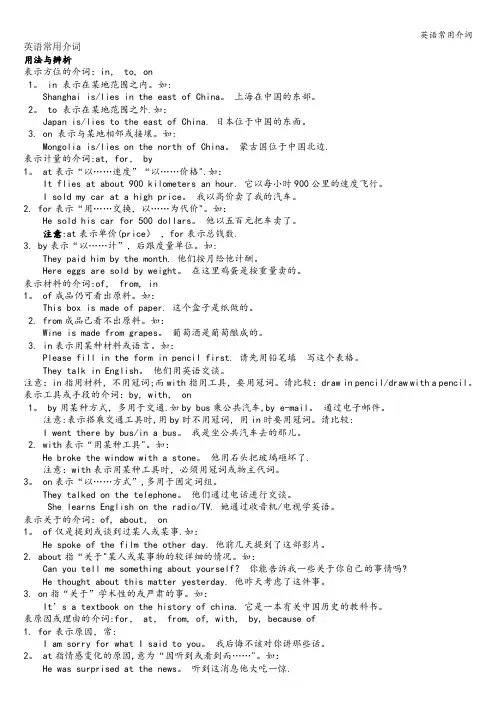
英语常用介词用法与辨析表示方位的介词:in, to, on1。
in 表示在某地范围之内。
如:Shanghai is/lies in the east of China。
上海在中国的东部。
2。
to 表示在某地范围之外.如:Japan is/lies to the east of China. 日本位于中国的东面。
3. on 表示与某地相邻或接壤。
如:Mongolia is/lies on the north of China。
蒙古国位于中国北边.表示计量的介词:at, for, by1。
at表示“以……速度”“以……价格".如:It flies at about 900 kilometers an hour. 它以每小时900公里的速度飞行。
I sold my car at a high price。
我以高价卖了我的汽车。
2. for表示“用……交换,以……为代价"。
如:He sold his car for 500 dollars。
他以五百元把车卖了。
注意:at表示单价(price),for表示总钱数.3. by表示“以……计”,后跟度量单位。
如:They paid him by the month. 他们按月给他计酬。
Here eggs are sold by weight。
在这里鸡蛋是按重量卖的。
表示材料的介词:of, from, in1。
of成品仍可看出原料。
如:This box is made of paper. 这个盒子是纸做的。
2. from成品已看不出原料。
如:Wine is made from grapes。
葡萄酒是葡萄酿成的。
3. in表示用某种材料或语言。
如:Please fill in the form in pencil first. 请先用铅笔填写这个表格。
They talk in English。
他们用英语交谈。
注意:in指用材料,不用冠词;而with指用工具,要用冠词。
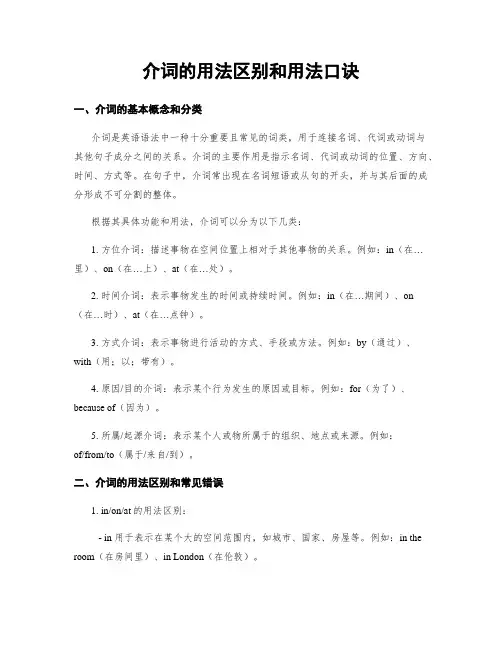
介词的用法区别和用法口诀一、介词的基本概念和分类介词是英语语法中一种十分重要且常见的词类,用于连接名词、代词或动词与其他句子成分之间的关系。
介词的主要作用是指示名词、代词或动词的位置、方向、时间、方式等。
在句子中,介词常出现在名词短语或从句的开头,并与其后面的成分形成不可分割的整体。
根据其具体功能和用法,介词可以分为以下几类:1. 方位介词:描述事物在空间位置上相对于其他事物的关系。
例如:in(在…里)、on(在…上)、at(在…处)。
2. 时间介词:表示事物发生的时间或持续时间。
例如:in(在…期间)、on (在…时)、at(在…点钟)。
3. 方式介词:表示事物进行活动的方式、手段或方法。
例如:by(通过)、with(用;以;带有)。
4. 原因/目的介词:表示某个行为发生的原因或目标。
例如:for(为了)、because of(因为)。
5. 所属/起源介词:表示某个人或物所属于的组织、地点或来源。
例如:of/from/to(属于/来自/到)。
二、介词的用法区别和常见错误1. in/on/at的用法区别:- in 用于表示在某个大的空间范围内,如城市、国家、房屋等。
例如:in the room(在房间里)、in London(在伦敦)。
- on 用于表示在某个平面或表面上,如桌子、地图等。
例如:on the table (在桌子上)、on the map(在地图上)。
- at 用于表示具体位置或地点,常与动词to be连用。
例如:at the bus stop (在公交车站)、at school(在学校)。
2. by/with的区别:- by 表示通过某种方式或手段进行某个行为。
例如:travel by plane(乘坐飞机旅行)、communicate by email(通过电子邮件交流)。
- with 表示使用某种工具或带有某种特征进行活动。
例如:write with a pen (用钢笔写字)、open the door with a key(用钥匙开门)。
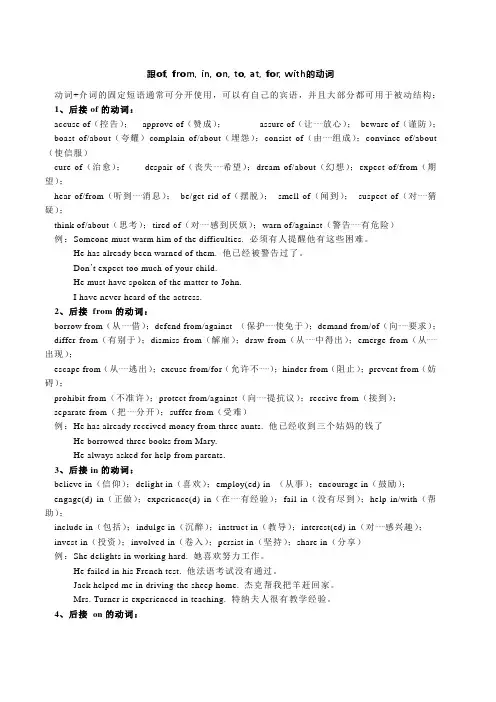
跟of, from, in, on, to, at, for, with的动词动词+介词的固定短语通常可分开使用,可以有自己的宾语,并且大部分都可用于被动结构:1、后接of的动词:accuse of(控告);approve of(赞成);assure of(让⋯⋯放心);beware of(谨防);boast of/about(夸耀)complain of/about(埋怨);consist of(由⋯⋯组成);convince of/about (使信服)cure of(治愈);despair of(丧失⋯⋯希望);dream of/about(幻想);expect of/from(期望);hear of/from(听到⋯⋯消息);be/get rid of(摆脱);smell of(闻到);suspect of(对⋯⋯猜疑);think of/about(思考);tired of(对⋯⋯感到厌烦);warn of/against(警告⋯⋯有危险)例:Someone must warm him of the difficulties. 必须有人提醒他有这些困难。
He has already been warned of them. 他已经被警告过了。
Don’t expect too much of your child.He must have spoken of the matter to John.I have never heard of the actress.2、后接from的动词:borrow from(从⋯⋯借);defend from/against (保护⋯⋯使免于);demand from/of(向⋯⋯要求);differ from(有别于);dismiss from(解雇);draw from(从⋯⋯中得出);emerge from(从⋯⋯出现);escape from(从⋯⋯逃出);excuse from/for(允许不⋯⋯);hinder from(阻止);prevent from(妨碍);prohibit from(不准许);protect from/against(向⋯⋯提抗议);receive from(接到);separate from(把⋯⋯分开);suffer from(受难)例:He has already received money from three aunts. 他已经收到三个姑妈的钱了He borrowed three books from Mary.He always asked for help from parents.3、后接in的动词:believe in(信仰);delight in(喜欢);employ(ed) in (从事);encourage in(鼓励);engage(d) in(正做);experience(d) in(在⋯⋯有经验);fail in(没有尽到);help in/with(帮助);include in(包括);indulge in(沉醉);instruct in(教导);interest(ed) in(对⋯⋯感兴趣);invest in(投资);involved in(卷入);persist in(坚持);share in(分享)例:She delights in working hard. 她喜欢努力工作。
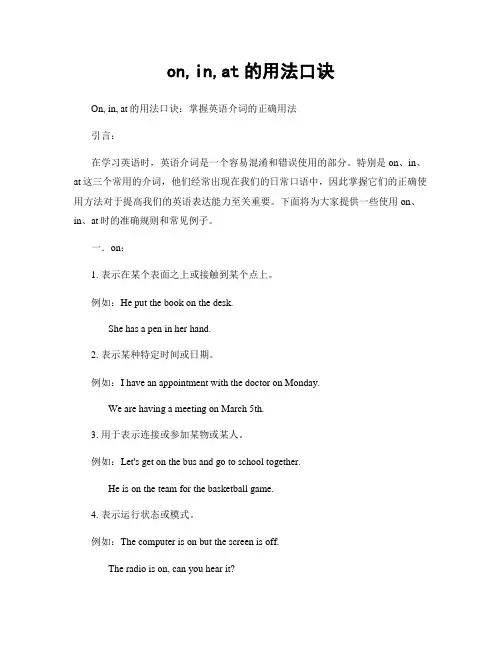
on,in,at的用法口诀On, in, at的用法口诀:掌握英语介词的正确用法引言:在学习英语时,英语介词是一个容易混淆和错误使用的部分。
特别是on、in、at这三个常用的介词,他们经常出现在我们的日常口语中,因此掌握它们的正确使用方法对于提高我们的英语表达能力至关重要。
下面将为大家提供一些使用on、in、at时的准确规则和常见例子。
一.on:1. 表示在某个表面之上或接触到某个点上。
例如:He put the book on the desk.She has a pen in her hand.2. 表示某种特定时间或日期。
例如:I have an appointment with the doctor on Monday.We are having a meeting on March 5th.3. 用于表示连接或参加某物或某人。
例如:Let's get on the bus and go to school together.He is on the team for the basketball game.4. 表示运行状态或模式。
例如:The computer is on but the screen is off.The radio is on, can you hear it?二.in:1. 表示在某个范围内、位置内或空间内。
例如:She lives in a small town near the mountains.I put my keys in my bag.2. 用于表示时间段或多长时间内发生了什么事情。
例如:I will have a vacation in July for two weeks.He finished the report in two hours.3. 用于表示一种状态或特征。
例如:She is interested in playing the piano.He is fluent in English.4. 表示一种情感、信仰或态度。
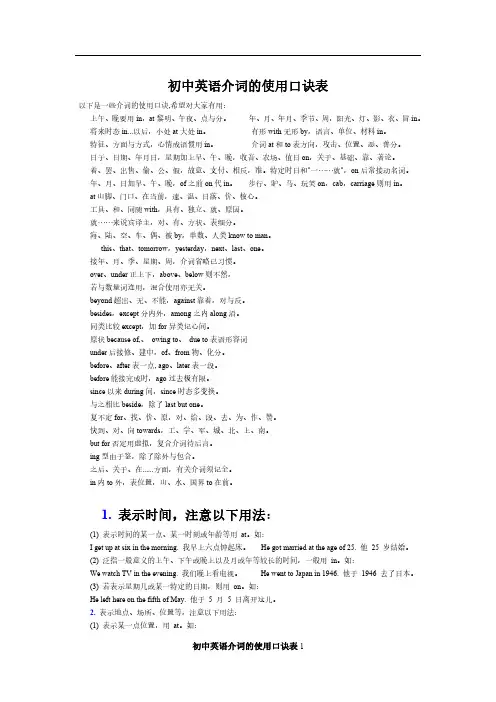
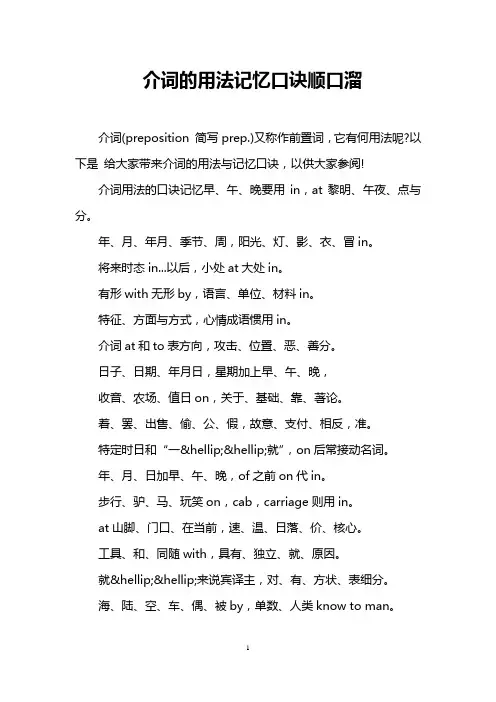
介词的用法记忆口诀顺口溜介词(preposition 简写prep.)又称作前置词,它有何用法呢?以下是给大家带来介词的用法与记忆口诀,以供大家参阅!介词用法的口诀记忆早、午、晚要用in,at黎明、午夜、点与分。
年、月、年月、季节、周,阳光、灯、影、衣、冒in。
将来时态in...以后,小处at大处in。
有形with无形by,语言、单位、材料in。
特征、方面与方式,心情成语惯用in。
介词at和to表方向,攻击、位置、恶、善分。
日子、日期、年月日,星期加上早、午、晚,收音、农场、值日on,关于、基础、靠、著论。
着、罢、出售、偷、公、假,故意、支付、相反,准。
特定时日和“一……就”,on后常接动名词。
年、月、日加早、午、晚,of之前on代in。
步行、驴、马、玩笑on,cab,carriage则用in。
at山脚、门口、在当前,速、温、日落、价、核心。
工具、和、同随with,具有、独立、就、原因。
就……来说宾译主,对、有、方状、表细分。
海、陆、空、车、偶、被by,单数、人类know to man。
this、that、tomorrow,yesterday,next、last、one。
接年、月、季、星期、周,介词省略已习惯。
over、under正上下,above、below则不然,若与数量词连用,混合使用亦无关。
‘beyond超出、无、不能,against靠着,对与反。
besides,except分内外,among之内along沿。
同类比较except,加for异类记心间。
原状because of,、owing to、due to表语形容词under后接修、建中,of、from物、化分。
before、after表一点, ago、later表一段。
before能接完成时,ago过去极有限。
since以来during间,since时态多变换。
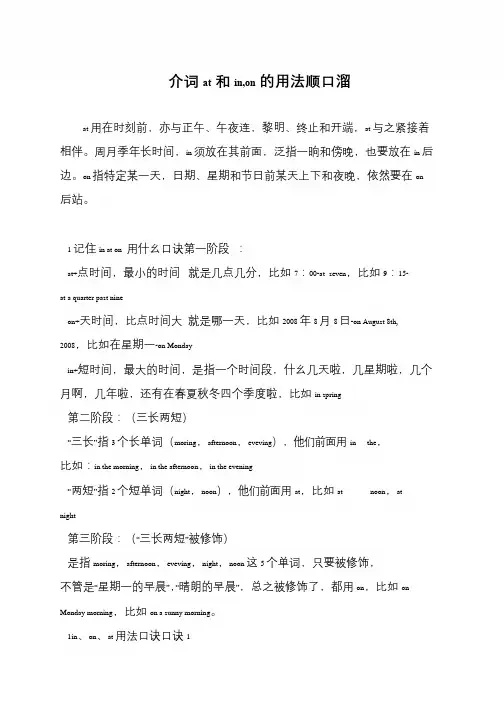
介词at和in,on的用法顺口溜
at 用在时刻前,亦与正午、午夜连,黎明、终止和开端,at 与之紧接着相伴。
周月季年长时间,in 须放在其前面,泛指一晌和傍晚,也要放在in 后边。
on 指特定某一天,日期、星期和节日前某天上下和夜晚,依然要在on 后站。
1 记住in at on 用什幺口诀第一阶段:
at+点时间,最小的时间就是几点几分,比如7:00-at seven,比如9:15-
at a quarter past nine
on+天时间,比点时间大就是哪一天,比如2008 年8 月8 日-on August 8th, 2008,比如在星期一-on Monday
in+短时间,最大的时间,是指一个时间段,什幺几天啦,几星期啦,几个月啊,几年啦,还有在春夏秋冬四个季度啦,比如in spring
第二阶段:(三长两短)
“三长”指3 个长单词(moring,afternoon,eveving),他们前面用in the,
比如:in the morning,in the afternoon,in the evening
“两短”指2 个短单词(night,noon),他们前面用at,比如at noon,at night
第三阶段:(“三长两短”被修饰)
是指moring,afternoon,eveving,night,noon 这5 个单词,只要被修饰,
不管是“星期一的早晨”,“晴朗的早晨”,总之被修饰了,都用on,比如on Monday morning,比如on a sunny morning。
1in、on、at 用法口诀口诀1。

介词at和in,on的用法顺口溜at 用在时刻前,亦与正午、午夜连,黎明、终止和开端,at 与之紧接着相伴。
周月季年长时间,in 须放在其前面,泛指一晌和傍晚,也要放在in 后边。
on 指特定某一天,日期、星期和节日前某天上下和夜晚,依然要在on 后站。
1 记住in at on 用什幺口诀第一阶段:at+点时间,最小的时间就是几点几分,比如7:00-at seven,比如9:15-at a quarter past nineon+天时间,比点时间大就是哪一天,比如2008 年8 月8 日-on August 8th, 2008,比如在星期一-on Mondayin+短时间,最大的时间,是指一个时间段,什幺几天啦,几星期啦,几个月啊,几年啦,还有在春夏秋冬四个季度啦,比如in spring第二阶段:(三长两短)“三长”指3 个长单词(moring,afternoon,eveving),他们前面用in the,比如:in the morning,in the afternoon,in the evening“两短”指2 个短单词(night,noon),他们前面用at,比如at noon,at night第三阶段:(“三长两短”被修饰)是指moring,afternoon,eveving,night,noon 这5 个单词,只要被修饰,不管是“星期一的早晨”,“晴朗的早晨”,总之被修饰了,都用on,比如on Monday morning,比如on a sunny morning。
1in、on、at 用法口诀口诀1年月周前要用in,日子前面却不行。
遇到几号要用on,上午下午又是in;要说某日上下午,用on 换in 才能行。
午夜黄昏用at,黎明用它也不借;口诀2at 也在时分前,说“差”用to,说“过”要用part;in 在……里,out 在……外,在旁边的是beside,靠近的为by ;on 在……上,under 在……下,above 在上头,below 在底下;口诀3this、that、tomorrow,yesterday,next、last、one,接年、月、季、星期、周,介词省略已习惯;over、under 正上下,above、below 则不然,若与数量词连用,混合使用亦无关;beyond 超出、无、不能,against 靠着,对与反;besides,except 分内外,among 之内along 沿;同类比较except,加for 异类记心间。
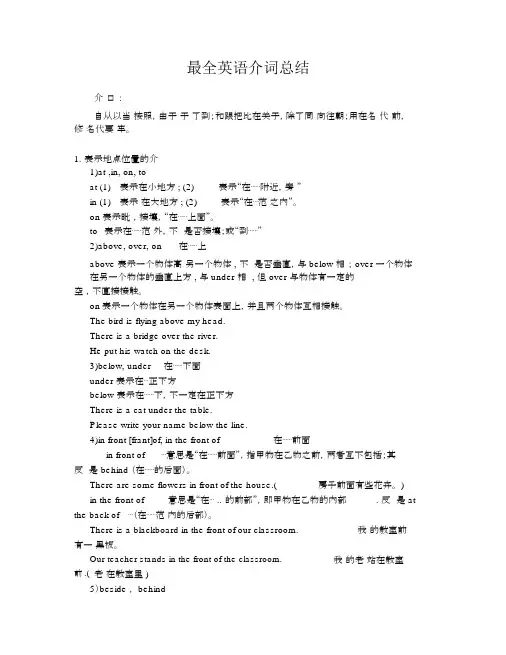
最全英语介词总结介口:自从以当按照,由于于了到;和跟把比在关于,除了同向往朝;用在名代前,修名代要牢。
1.表示地点位置的介1)at ,in, on, toat (1) in (1)表示在小地方 ; (2)表示在大地方 ; (2)表示“在⋯⋯附近,旁”表示“在⋯范之内”。
on 表示毗,接壤,“在⋯⋯上面”。
to表示在⋯⋯范外,不是否接壤;或“到⋯⋯”2)above, over, on在⋯⋯上above 表示一个物体高另一个物体 , 不是否垂直,与 below 相; over 一个物体在另一个物体的垂直上方 , 与 under 相 , 但 over 与物体有一定的空,不直接接触。
on表示一个物体在另一个物体表面上,并且两个物体互相接触。
The bird is flying above my head.There is a bridge over the river.He put his watch on the desk.3)below, under在⋯⋯下面under 表示在⋯正下方below 表示在⋯⋯下,不一定在正下方There is a cat under the table.Please write your name below the line.4)in front [frant]of, in the front of在⋯⋯前面in front of⋯意思是“在⋯⋯前面”,指甲物在乙物之前,两者互不包括;其反是 behind (在⋯⋯的后面)。
There are some flowers in front of the house.(房子前面有些花卉。
) in the front of意思是“在⋯..的前部”,即甲物在乙物的内部. 反是 at the back of⋯(在⋯⋯范内的后部)。
There is a blackboard in the front of our classroom.我的教室前有一黑板。
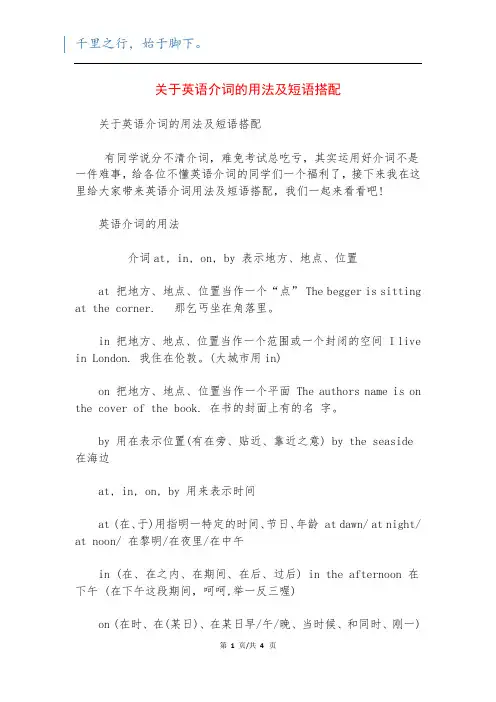
关于英语介词的用法及短语搭配关于英语介词的用法及短语搭配有同学说分不清介词,难免考试总吃亏,其实运用好介词不是一件难事,给各位不懂英语介词的同学们一个福利了,接下来我在这里给大家带来英语介词用法及短语搭配,我们一起来看看吧!英语介词的用法介词at, in, on, by 表示地方、地点、位置at 把地方、地点、位置当作一个“点” The begger is sitting at the corner. 那乞丐坐在角落里。
in 把地方、地点、位置当作一个范围或一个封闭的空间 I live in London. 我住在伦敦。
(大城市用in)on 把地方、地点、位置当作一个平面 The authors name is on the cover of the book. 在书的封面上有的名字。
by 用在表示位置(有在旁、贴近、靠近之意) by the seaside 在海边at, in, on, by 用来表示时间at (在、于)用指明一特定的时间、节日、年龄 at dawn/ at night/ at noon/ 在黎明/在夜里/在中午in (在、在之内、在期间、在后、过后) in the afternoon 在下午 (在下午这段期间,呵呵,举一反三喔)on (在时、在(某日)、在某日早/午/晚、当时候、和同时、刚一)on the first 在一号(指某月一号,如二号要说second等。
其实意思是指某月的第几天)by (的时候、到、等到已经) 用在天、时间 by 2 oclock 到两点钟for, since 用于表示时间用 for 用计量时间(年、月、日、时、分、秒等) He held his breath for five minutes. 他闭息达五分钟。
用 since 表示明确的日期或时间 Hes woked here since 1980. 自从1970年他就在此工作。
表示动作的介词:to ,toward或不用介词用 to 表示向某处移动 They were driving to work together. 他们一同开车去工作。
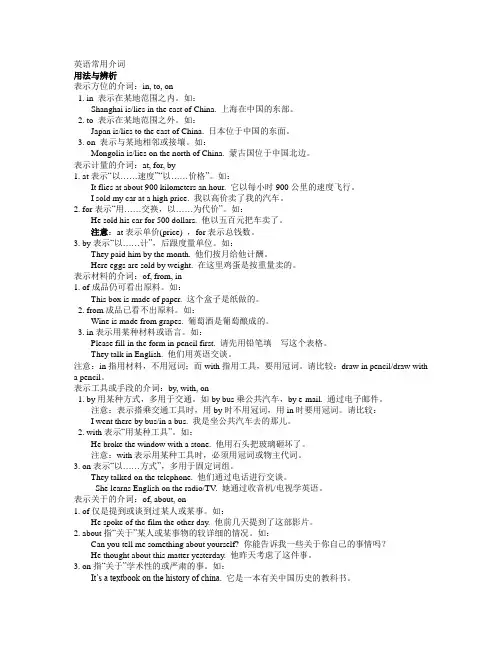
英语常用介词用法与辨析表示方位的介词:in, to, on1. in 表示在某地范围之内。
如:Shanghai is/lies in the east of China. 上海在中国的东部。
2. to 表示在某地范围之外。
如:Japan is/lies to the east of China. 日本位于中国的东面。
3. on 表示与某地相邻或接壤。
如:Mongolia is/lies on the north of China. 蒙古国位于中国北边。
表示计量的介词:at, for, by1. at表示“以……速度”“以……价格”。
如:It flies at about 900 kilometers an hour. 它以每小时900公里的速度飞行。
I sold my car at a high price. 我以高价卖了我的汽车。
2. for表示“用……交换,以……为代价”。
如:He sold his car for 500 dollars. 他以五百元把车卖了。
注意:at表示单价(price) ,for表示总钱数。
3. by表示“以……计”,后跟度量单位。
如:They paid him by the month. 他们按月给他计酬。
Here eggs are sold by weight. 在这里鸡蛋是按重量卖的。
表示材料的介词:of, from, in1. of成品仍可看出原料。
如:This box is made of paper. 这个盒子是纸做的。
2. from成品已看不出原料。
如:Wine is made from grapes. 葡萄酒是葡萄酿成的。
3. in表示用某种材料或语言。
如:Please fill in the form in pencil first. 请先用铅笔填写这个表格。
They talk in English. 他们用英语交谈。
注意:in指用材料,不用冠词;而with指用工具,要用冠词。
初中英语语法:介词的用法归纳介词是一种用来表示词与词,句子与句子之间关系的词。
介词是一种虚词,不能独立使用。
介词之后一般有名词或代词(宾格)或相当于名词的其他词类、短语或从句作它的宾语,即构成介词短语。
有些介词是由两个以上的词构成的短语介词,如:out of(从…中出来),because of(因为),away from(距离…),on top of(在…顶上),ever since(自从…),next to(在…隔壁),according to(根据…),in front of(在…前方)等。
一、介词的分类1、按构成方式,可分为:①简单介词:即一个介词;②合成介词:由两个介词构成合成词;③短语介词:由短语构成;④双重介词:由两个介词搭配而成;⑤分词介词:由现在分词转化而来;⑥兼类介词:由形容词直接转化而来;2、按所表示的意义,可分如下几类:①地点(位置、范围)介词;②方向(目标趋向)介词;③时间介词;④方式介词;⑤涉及介词;⑥其它介词:目的介词,原因介词,比较介词,伴随/状态介词。
二、介词短语的句法作用介词与其宾语一起构成的短语叫做介词短语,可在句子中充当一定成分,通常用作状语、定语和表语和宾语补足语。
如:The man camedown the stairs。
(状)(那个人走下楼来)The womanwith a flower on her headisfrom the countryside.(定)(头上戴花的妇女来自乡下)The teacher is nowwith the pupils.(表)(老师现在和学生在一起)When she woke up,she found herselfin hospital.(宾补)当她醒来时,发现自己已经在医院里。
三、介词短语在句子中的位置介词短语做状语时,如果表示时间/地点,可以放在句首或句尾。
如果表示方向/方式/伴随/涉及/原因/目的/比较,一般放在句尾;介词短语作表语时放在连系动词之后;介词短语作定语时,只能放在被修饰的名词之后。
40个英语介词用法总结1. At: 表示时间、位置或状态,例如at 3 o"clock, at the park, at peace.2. In: 表示时间、位置或状态,例如in May, in the room, in trouble.3. On: 表示日期、时间、表面或状态,例如on Monday, on the table, on fire.4. By: 表示手段、方法或时间,例如by train, by email, by noon.5. For: 表示目的、受益者或时间期限,例如for fun, for him, for two weeks.6. To: 表示方向、目的地或比较,例如to school, to London, to me.7. From: 表示起点、来源或分离,例如from home, from China, from each other.8. Into: 表示进入、转化或改变,例如into the house,into a pumpkin, into a butterfly.9. Out of: 表示脱离、从中取出或缺乏,例如out of the room, out of money, out of the blue.10. With: 表示伴随、附带或具备,例如with friends, witha smile, with experience.11. Without: 表示没有、不带或缺少,例如withoutpermission, without shoes, without doubt.12. Over: 表示覆盖、超过或结束,例如over the roof, over the limit, over and done with.13. Under: 表示在下面、被支配或不足,例如under the table, under his control, under budget.14. About: 表示关于、大约或忙于,例如about the movie, about 10 dollars, about to leave.15. Above: 表示在上面、高于或超过,例如above the clouds, above average, above suspicion.16. Below: 表示在下面、低于或不足,例如below the surface, below freezing, below par.17. Across: 表示横穿、相交或涉及,例如across the street, across the board, across his mind.18. Beyond: 表示超出、远离或除了,例如beyond repair, beyond belief, beyond her control.19. Around: 表示周围、附近或环绕,例如around the corner, around the clock, around the world.20. Before: 表示以前、在前面或比较,例如before noon, before the house, before his time.21. Behind: 表示在后面、落后或背后,例如behind the house, behind schedule, behind the scenes.22. Beside: 表示在旁边、与...相比或附加,例如besidethe river, beside myself, beside the point.23. Inside: 表示内部、在里面或被包含,例如inside the box, inside the building, inside information.24. Outside: 表示外部、在外面或超出,例如outside the house, outside the box, outside the norm.25. Through: 表示穿过、经过或完成,例如through the door, through the park, through with it.26. Throughout: 表示遍布、贯穿或在整个期间,例如throughout the city, throughout history, throughout the day.27. Towards: 表示朝向、对于或接近,例如towards the sun, towards him, towards the end.28. Against: 表示反对、抵抗或紧挨着,例如against the law, against the current, against the wall.29. Among: 表示在...之中、相互之间或被分配到,例如among friends, among the stars, among the winners.30. Between: 表示在两者之间、在中间或相互之间,例如between two trees, between classes, between you and me.31. Within: 表示在内部、在范围之内或在规定时间内,例如within the house, within the budget, within a week.32. Without: 表示在外面、没有或不用,例如without the room, without a doubt, without further ado.33. Beneath: 表示在下面、低于或不足,例如beneath the surface, beneath his dignity, beneath contempt.34. Beside: 表示在旁边、与...相比或附加,例如beside the river, beside myself, beside the point.35. Into: 表示进入、转化或改变,例如into the house, into a pumpkin, into a butterfly.36. Upon: 表示在...之上、一旦发生或基于,例如upon the hill, upon arrival, upon further consideration.37. With: 表示伴随、附带或具备,例如with friends, witha smile, with experience.38. Within: 表示在内部、在范围之内或在规定时间内,例如within the house, within the budget, within a week.39. Without: 表示没有、不带或缺少,例如without permission, without shoes, without doubt.40. Beneath: 表示在下面、低于或不足,例如beneath the surface, beneath his dignity, beneath contempt.。
英语介词的含义及其用法介词的知识点有哪些英语介词的含义及其用法介词是英语语法中的重要部分,用于连接名词、代词、动词或其他词组,以表达它们之间的关系。
介词通常放置在名词或代词之前,并且与它们一起构成短语。
本文将探讨英语介词的含义及其用法,帮助读者更好地理解和运用介词。
一、介词的含义介词用于表示词与词之间、短语与短语之间、或者句子与句子之间的关系。
它可以表达时间、地点、方向、原因、目的、手段等方面的含义。
常见的介词包括in、on、at、from、to、with、by、for等,它们各自有不同的用法和含义。
二、表示时间的介词1. at:表示具体的时间点,如at 7 o'clock(在7点钟)。
2. on:表示某一天或具体日期,如on Monday(在星期一)、on July 1st(在7月1日)。
3. in:表示一段时间,如in the morning(在早上)、in June(在六月)。
三、表示地点的介词1. in:表示大的地区或范围,如in China(在中国)、in the room (在房间里)。
2. on:表示平面上的位置,如on the table(在桌子上)。
3. at:表示具体的地点,如at the park(在公园)。
四、表示方向的介词1. to:表示朝向某个地方或目标,如go to school(去学校)。
2. from:表示从某个地方出发,如come from China(来自中国)。
3. into:表示进入某个地方,如go into the house(进入房子)。
五、表示原因和目的的介词1. for:表示目的或用途,如for studying(为了学习)。
2. because of:表示因为,如because of the rain(因为下雨)。
六、表示手段的介词1. with:表示使用某种手段,如write with a pen(用钢笔写)。
2. by:表示通过某种手段,如travel by plane(乘飞机旅行)。
on和in在树上怎么区别指树本身的东西,如果实和花朵,使用它们onthetree。
指停留在树上的鸟、虫、猴等树外的物品,使用inthetree。
一、on和in如何区分树上1.一般来说,树本身的东西,也就是长在树上的东西,如果是真的和花,需要使用介词on,即onthetree;树外的东西,如停留在树上的鸟、虫子和猴子,需要使用介词in,即inthetree。
2、“onthetree”例句:Therearetwoapplesonthetree.树上结了两个苹果;Theapplesrottedonthetree.苹果在树上腐烂;Afewflowersstillremainedonthetree.树上还剩下几朵花。
3、“inthetree”例句:Therearetwosparrowsinthetree.树上有两只麻雀;Themonkeywasswinginginthetree.猴子在树上荡来荡去;There'sabirdinthetree.树上有一只鸟。
二、介词分类1、按构成分类:(1)简单介词,包括in、on、with、by、for、at、about、under、of、to等。
(2)合成介词,包括into、throughout、within、outside、inside、without介词由两个单词组成。
(3)重叠介词,包括fromamong(从……当中)、frombehind (从……后面)、untilafter(直至……之后)、atabout (在大约……)、afterabout(在大约……之后)等。
(4)短语介词,一个或两个简单介词和一个或几个其他词构成一个短语,相当于一个介词。
这种介词的结尾总是一个简单的介词,比如becauseof、accordingto、inadditionto、bymeansof、inspiteof、infrontof、into等。
(5)分词介词,有极少数介词的词尾是-ing,类似于现在的分词(其中一些可以作为分词)。
介词的作用和用法介词是用来表示名词或代词与其他词之间关系的词类,它一般位于名词或代词之前。
介词的作用和用法如下:1. 表示地点或位置关系:at(在)、in(在)、on(在)、over (在…上方)、under(在…下方)、beside(在…旁边)、among(在…中间)等。
例如:I live in a house.(我住在一座房子里。
)2. 表示时间关系:in(在…之内)、on(在…的具体日期)、at (在…的具体时间)、from...to(从…到…)等。
例如:The meeting will start at 9 o'clock.(会议将于9点开始。
)3. 表示方向或运动关系:to(到)、from(从)、through(穿过)、across(横穿)、towards(朝向)、along(沿着)等。
例如:She walked to the park.(她走到了公园。
)4. 表示原因或目的关系:for(为了)、because of(因为)、with (由于)、to(为了)、of(关于)等。
例如:He bought a gift for his sister.(他给他妹妹买了一份礼物。
)5. 表示手段或方式关系:by(通过)、with(用)、like(像)、as(作为)等。
例如:They traveled by train.(他们乘火车旅行。
)6. 表示比较或对比关系:like(像)、as(像)、than(比)、with(与)等。
例如:She is taller than her brother.(她比她的兄弟高。
)7. 表示属于或关系:of(的)、about(关于)、by(由)等。
例如:The book of John is on the table.(约翰的书在桌子上。
)需要注意的是,不同的介词在不同的句子中可能有不同的用法和意义,因此根据具体语境和句意来选择正确的介词使用。
英语介词的用法口诀英语介词的用法口诀如下:1. in在……里,out在……外,在旁边的是beside,靠近的为by。
on 在……上,under在……下,above在上头,below在底下。
2. this、that、tomorrow,yesterday,next、last、one。
接年、月、季、星期、周,介词省略已习惯。
over、under正上下,above、below则不然,若与数量词连用,混合使用亦无关。
3. before、after表一点,ago、later表一段。
4. 早、午、晚要用in;at黎明、午夜、点与分;年、月、年月、季节、周、阳光、灯、影、衣、冒(雨)用in;将来时态in表以后;小处at,大处in;有形with无形by;语言、单位、材料in。
5. because of、owing to、due to表语形容词under后接修、建中,of、from物、化分。
before、after表一点,ago、later表一段。
before能接完成时,ago过去极有限。
since以来during间,since时态多变换。
与之相比beside,除了last but one。
复不定for、找、价、原,对、给、段、去、为、作、赞。
快到、对、向towards,工、学、军、城、北、上、南。
but for否定用虚拟,复合介词待后言。
ing型由于鉴,除了除外与包合。
之后、关于、在......方面,有关介词须记全。
in内to外表位置,山、水、国界to在前。
6. 日子前面却不行。
遇到几号要用on,上午下午又是in。
要说某日上下午,用on换in才能行。
午夜黄昏用at,黎明用它也不借。
at也在时分前,说“差”用to,说“过”要用part。
7. over、under正上下,above在上头,below在底下。
若与数量词连用,混合使用亦无关。
8. besides,except分内外,among之内along沿。
同类比较except,加for异类记心间。
介词用法知多少介词是英语中最活跃的词类之一。
同一个汉语词汇在英语中可译成不同的英语介词。
例如汉语中的“用”可译成:(1)用英语(in English);(2)用小刀(with a knife);(3)用手工(by hand);(4)用墨水(in ink)等。
所以,千万不要以为记住介词的一两种意思就掌握了这个介词的用法,其实介词的用法非常广泛,搭配能力很强,越是常用的介词,其含义越多。
下面就简单介绍几组近义介词的用法及其搭配方法。
一. in, to, on和off在方位名词前的区别1. in表示A地在B地范围之内。
如:Taiwan is in the southeast of China.2. to表示A地在B地范围之外,即二者之间有距离间隔。
如:Japan lies to the east of China.3. on表示A地与B地接壤、毗邻。
如:North Korea is on the east of China.4. off表示“离……一些距离或离……不远的海上”。
如:They arrived at a house off the main road.New Zealand lies off the eastern coast of Australia.二. at, in, on, by和through在表示时间上的区别1. at指时间表示:(1)时间的一点、时刻等。
如:They came home at sunrise (at noon, at midnight, at ten o’clock, at daybreak, at dawn). (2)较短暂的一段时间。
可指某个节日或被认为是一年中标志大事的日子。
如:He went home at Christmas (at New Year, at the Spring Festival, at night).2. in指时间表示:(1)在某个较长的时间(如世纪、朝代、年、月、季节以及泛指的上午、下午或傍晚等)内。
如:in 2004, in March, in spring, in the morning, in the evening, etc(2)在一段时间之后。
一般情况下,用于将来时,谓语动词为瞬间动词,意为“在……以后”。
如:He will arrive in two hours.谓语动词为延续性动词时,in意为“在……以内”。
如:These products will be produced in a month.注意:after用于将来时间也指一段时间之后,但其后的时间是“一点”,而不是“一段”。
如:He will arrive after two o’clock.3. on指时间表示:(1)具体的时日和一个特定的时间,如某日、某节日、星期几等。
如:On Christmas Day(On May 4th), there will be a celebration.(2)在某个特定的早晨、下午或晚上。
如:He arrived at 10 o’clock on the night of the 5th.(3)准时,按时。
如:If the train should be on time, I should reach home before dark.4. by指时间表示:(1)不迟于,在(某时)前。
如:He will come by six o’clock.Jack had made some friends by the time you came.(2)在……间,在……的时候。
如:He worked by day and slept by night.5. through指时间意为“从……开始到结束”,此时与throughout相同。
如:We work hard all through the year.三. near, by, beside, at表示“在……附近”时的区别1. near表示相对的近,实际距离可能还很远。
如:Suzhou is near Shanghai.2. by和beside都表示靠近,实际距离不可能很远,但beside比by更具体地表示出“在……旁边”的意思。
如:He was sitting beside her.3. at也有“在旁边”的意思,但多表示有目的的行为所处的位置,而by和beside仅表示位置关系。
如:The students are sitting at the desks listening to the teacher.Several students are sitting by / beside the window talking about a film.四. at, in和on表示地点时的区别1. at表示地点:(1)用于指较小的地方。
如:I shall wait for you at the station.(2)用于门牌号码前。
如:He lives at 115 Zhongshan Road.2. in表示地点:(1)用于指较大的地方。
如:He lives in Shanghai.(2)虽然是很小的地方,如果说话人住在那里,也可用in。
商店、学校、机关等,若看作一个地点(point)用at,若看作一个场所(place)用in。
如:I met him at the post-office.I’m now working in the post-office.3. on表示地点,一般指与面或线接触,意为“在……上;在……旁”。
如:The picture was hanging on the wall.New York is on the Hudson River.五. besides, except, except for, but表示“除……外”之间的区别1. besides表示“除了……以外,还有……”,具有附加性质。
如:Besides Mr Wang, we also went to see the film.(王先生也去了)注意:besides用于否定句中时,与except, but同义,可互换。
如:We have no other books besides / except these.2. except表示“……除外”,具有排它性质。
如:We all went to see the film except Mr Wang.(王先生没去)3. except for表示“除了……”,即表示除去整体中的一部分。
如:The composition is very good except for a few spelling mistakes.4. but意为“除了”,与except同义,except强调被排除的部分,but则强调整句的内容,常修饰否定意义的代词。
如:Nobody knew it but me.时间介词in, on与at的用法介词in, on与at都可用于表示时间的名词前,但用法各不相同,其区别在于:一、用in的场合(1)表示“在某年/月/季节”这个含义时,须用介词in。
例如:She came to this city in 1980.他于1980年来到这个城市。
It often rains here in summer.夏天这里常常下雨。
(2)表示“从现在起一段时间以后”时,须用介词in。
例如:They will go to see you in a week.他们将在一周后去看望你。
I will be back in a month.我将在一个月后回来。
(3)表示“在某世纪”时,须用介词in.例如:This machine was invented in the eighteenth century.这台机器是在18世纪发明的.Great changes took place in the twentieth century.20世纪发生了巨大变化.(4)表示“在某年代或特定世纪某年代”时,须用介词in。
例如:This incident happened in the 1970''''s.该事件发生在20世纪70年代。
The Anti-Japanese War broke out in the 1930''''s.抗日战争爆发于20世纪30年代。
除此之外,morning / evening / afternoon 三个词也常跟介词in连用。
例如:Don't watch TV too much in the evening.晚上看电视不要太多。
They sometimes play games in the afternoon.他们有时在下午做游戏。
二、用on的场合(1)表示“在具体的某一天”或“(在具体的某一天的)早上、中午、晚上”等,须用介词on。
例如:Jack was born on May 10th,1982.杰克生于1982年5月10日。
They left on a rainy morning.他们是在一个雨天的早上离开的。
He went back to America on a summer afternoon.他于一个夏天的下午返回了美国。
(2)表示“在星期几”或“在星期几的早上、中午、晚上”等,须用介词on。
例如:We don't go to school on Saturday and Sunday.我们星期六和星期天不上学。
What time do you get up on weekdays?你在平日什么时候起床?I heard this story on Saturday morning.我是在星期六的早晨听到这个故事的。
(3)表示“在某一节日”时,须用介词on。
例如:We usually eat moon cakes on Mid-autumn Festival.我们通常在中秋节吃月饼。
Mr Hu received a card on Teachers' Day.胡老师在教师节那天收到了一张卡片。
注意:当morning, evening, afternoon被of短语修饰,习惯上用in,而不用on.例如:in the early morning of September 10th 在9月10的清晨;in the late afternoon of September 12th 在9月12日的傍晚。
三、用at的场合(1)表示“某一具体时刻(即几点几分时)”,须用介词at。
例如:He gets up at six o'clock every day .他每天六点起床。